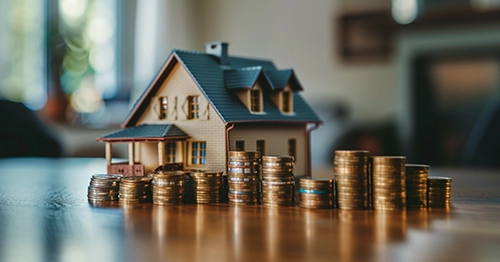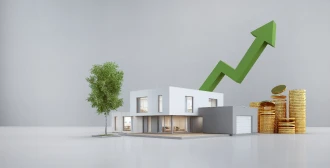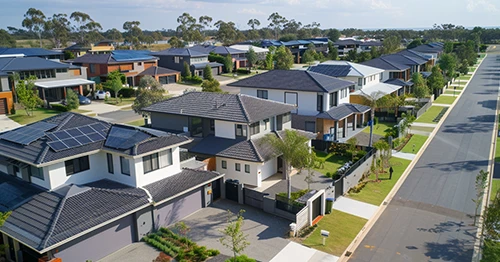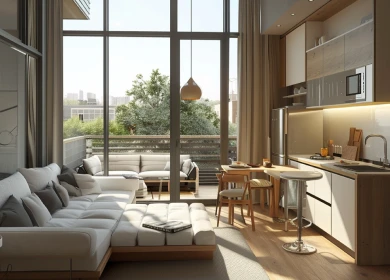Updated: 29 May, 2025
Table of Contents
- What Is The Ripple Effect?
- What Triggers The Ripple Effect?
- The Progression Of A Typical Price Ripple
- Cause 1: How Do First Home Buyers Start The Ripple Effect In The Property Market?
- Cause 2: What Happens To Price Ripples When Current Homeowners Decide To Upsize
- Cause 3: How Does Investor Activity Boost The Ripple Effect?
- Cause 4: How Do Potential Retirees Fit Into The Price Ripple?
- Where Will The Next Ripple Effect Occur?
- How To Spot The Ripple Effect?
- Are There Any Limitations To The Ripple Effect?
- Are You Looking To Buy Your First Home In Sydney?
Have you ever noticed ripples over a pond?
Much like those rippling waves, the growth in property price, too, tends to exhibit a wave-like pattern that flows from one location to the other over time, creating something like a ripple effect.
It’s something that some property market experts believe to be a recurring event and a cumulative result of an imbalance between housing demand and supply.
They’re convinced that these price ripples start typically from capital cities and gradually continue to spread outwards into the neighbouring suburbs, and then into closer mountain locations and coastal areas, until property values, more or less, level across the market.
They’re also saying that this ripple effect in the property market is somewhat predictable and comparing the price movements across specific locations can, thus, give us a bit of a guide to figure out where the next price growth may occur.
Knowing that, in turn, may help you make the right decision when buying a property, whether it’s for residential use or investment purpose.
What Is The Ripple Effect?
Most people usually prefer moving into cities or inner suburbs because they want to be closer to their workplace and enjoy the lifestyle perks of urban centres.
When too many people try to get into the property market around the same time, the housing demand goes up. As demand exceeds supply, prices increase, making the market less affordable.
What happens next is that potential home buyers start looking for properties in the surrounding suburbs that haven’t yet caught up to the price growth.
Eventually, these inner suburbs also start experiencing increased housing demand as more people try to acquire properties there.
When the demand eventually exceeds the housing supply in the inner suburbs as well, people will try to find properties further into the outer suburbs, and then into the coastal areas and mountain regions.
This way, the price growth ripples across various locations in a property market starting from high-end areas towards the surrounding areas, followed by the outer regions.
This is what the experts are calling the ripple effect.
It’s also referred to as osmosis or the domino effect in other parts of the world.
What Triggers The Ripple Effect?
Experts believe that the ripple effect occurs almost always, at least initially, because of first home buyers activity.
But there are other chain of events or causes that help propagate the price ripples across the property market.
These causes are:
- First home buyers flocking into one area to acquire properties.
- Former first home buyers trying to flip their first dwelling and upgrade to larger homes.
- Investors who are looking to rip profits from those areas where the price is growing.
- Potential retirees using their existing equity to downsize and keep a retirement nest egg.
The Progression Of A Typical Price Ripple
| First-home buyers | Upgraders | Investors | Investors | |
|---|---|---|---|---|
| Causes | First home buyer incentives, lower interest, affordable mortgage | Use increased equity to upsize to a larger home, better location | Profit from the overall price growth in the market | Use growth in equity to downsize and keep a retirement egg |
| Locations | Less expensive, inner and outer suburbs | High-end, well-established suburbs | Wherever the price is growing | Coastal, waterfront, mountain areas |
Cause 1: How Do First Home Buyers Start The Ripple Effect In The Property Market?
First home buyers generally cannot afford to buy properties in the capital cities since most of them are on a budget.
But when market conditions turn into their favour backed by falling interest rates, easy access to mortgage, government grants, tax concessions or downfall of the property values, most of them try to get into the affordable property markets around the major cities as quickly as possible.
As hordes of first home buyers cause the demand to increase in a particular locale, the housing affordability plummets. The rising prices naturally push those with limited deposits out of those property markets and force them to look for cheaper commuter suburbs that are very close to the cities.
This is how the ripple effect usually starts in a property market.
Historically, price ripples have occured in 2000 and 2012.
- First, in 2000, when the Federal government introduced the First Home Owners Grant of $14,000 for newly-built homes, and $7,000 for established homes.
- And, in 2012, when the RBA slashed the cash rates twice: first on October to 3.25%, and second on December to 3.00%.
Encouraged by these changes, many first home buyers rushed into the housing market. In Sydney and Melbourne, although the housing demand started to rise, it was concentrated around low-end areas initially. So, the median housing price took some time to rise.
When it did rise, it rippled from Central Business Districts (CBDs) to the closet inner suburbs and towns, pushing the first home buyers on a budget further out from the high-density areas into the affordable neighbourhoods, thereby, perpetuating the ripple effect.
Cause 2: What Happens To Price Ripples When Current Homeowners Decide To Upsize
Most prospective first home buyers tend to purchase their first homes from former first home buyers, who are looking to upgrade.
These homeowners also try to take advantage of the ripe market conditions and their increased equity to move into larger, better residences in more affluent suburbs. So, as they start selling off their existing homes and try to move into more established suburbs, another instance of the ripple effect occurs.
With more and more existing homeowners turning into upgraders, two price ripples come into play simultaneously – one, caused by first home buyers moving further outwards into developing suburbs and the other, a result of upgraders moving inwards into the established areas.
At this point, the entire regional property market experiences a significant growth in property value, but it’s the investors that actually intensify the price ripple.
Cause 3: How Does Investor Activity Boost The Ripple Effect?
Unlike first home buyers and upgraders, investors don’t particularly buy properties closer or farther from the city centres.
Because prices are growing across the region, investors flock into the property market to make profit from capital gains and rental yields. When investor activities saturate, it creates yet another wave of housing demand, which puts an upward pressure on the already growing property prices.
This is what creates a property market boom, much like in Sydney in 2016 and in Melbourne in 2016-2017. Sydney was tracking a 19.2% growth in property prices in 2016 while Melbourne prices rose by 17.1% in 2016 and by 12.1% in 2017, according to the CoreLogic data.
But investors are just another component of the price ripple. Even after Australian Prudential Regulation Authority (APRA) and the Foreign Investment Review Board (FIRB) introduced measures to curb investor activity, the property prices continue to ripple with the final component of the process — the retirees.
Cause 4: How Do Potential Retirees Fit Into The Price Ripple?
As the property market booms, even the prospective retirees try to make the most of it.
Most of them who own properties in the cities and inner suburbs, look to downsize their current homes so that they can easily arrange or boost a nest egg for their retirement. So they sell their existing high-value dwellings and opt to move into smaller homes at coastal areas or countrysides where the prices are still very affordable.
Again, as more and more retirees choose to buy properties around coasts, countrysides and mountains, the final ripples of price growth hit these areas. Soon enough, these places also become unaffordable and the retirees start buying cheaper properties in nearby places.
This is when the price growth ripples start to weaken with property values stagnating within the cities and inner suburbs.
Where Will The Next Ripple Effect Occur?
Property prices in Sydney and Melbourne have gone up a little since mid-2019 due to cash rate cuts, loosening of the borrowing power and election results. The housing demand is steadily rising as is the population in these capital cities.
Additionally, the recent First Home Loan Deposit Scheme (FHLDS) is all set to help 10,000 first home buyers to move into their first dwelling. Another 10,000 of them will soon be eligible come July 2020.
Stars may very well be aligning for many aspiring first home buyers. As property prices in Sydney and Melbourne continue to climb, most of them with limited deposits will use FHLDS, government grants and tax exemptions to gradually venture into the inner and outer suburbs.
Another region to watch is Tasmania, where the property markets in both capital and rest of the region have performed quite well even when the other capital cities were going through a downturn.
Compared to a national drop of 4.8% in 2018, with Sydney falling by 8.9% and Melbourne by 7%, housing prices jumped 8.7% in Hobart and 9.9% in regional Tasmania. Tasmania continued on this upward trajectory in 2019 as well posting 12.2% growth in regional areas and a 9.3% rise in Hobart, outpacing both Sydney and Melbourne.
Could this be the sign of a price ripple?
Perhaps.
However, it would be wise to understand that Tasmania doesn’t have enough job growth at the moment— and, hence, population growth — to sustain its housing demand. That is to say, the growth in property price may not linger for too long.
How To Spot The Ripple Effect?
If you can remember these three simple rules of price ripple, you might just be able to spot one for yourself.
- The ripple effect starts when property prices become too expensive in high-density, high-demand areas.
- The housing demand then shifts to surrounding places where prices are affordable.
- Prices, in these places, rises only when the housing demand there exceeds the supply.
Are There Any Limitations To The Ripple Effect?
There may be.
Case in point: The ripple effect in the NSW housing market from 2013 to 2017.
The ripple effect can sometimes miss the closer suburbs
When a 2013 price ripple from Sydney began spreading across the surrounding areas, it hit Central Coast in 2014 and New Castle in 2015. But places like Wollongong and Blue Mountains, Central Coast and Newcastle experienced the price ripple only in 2016 and 2017 respectively despite being much closer to Sydney.
What this implies is that the ripple effect can sometimes completely bypass nearby suburbs.
| City/Region | Years Prices Grew | Distance From City |
|---|---|---|
| Sydney | 2013 | 0km |
| Central Coast | 2014 | 70-90km |
| Newcastle | 2015 | 150km+ |
| Wollongong | 2016 | 70-90km |
| Blue Mountains | 2017 | 40-60km |
Are You Looking To Buy Your First Home In Sydney?
Buying your first home in Sydney can be a very quick process as most homes are auctioned off. Usually, you’ll have to renounce your right to a cooling-off period.
So, it’s better to get pre-approved for a home loan prior to attending auctions or entering into a private sale. Our experienced mortgage brokers recommend getting 2 or more pre-approvals because it is quite risky to have just one lender who can assist.
Speak with one of our specialist mortgage brokers by giving us a call on 1300 889 743 or by filling in on our online assessment form today.






